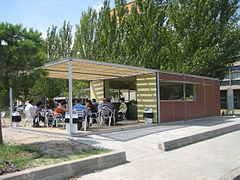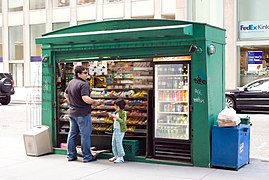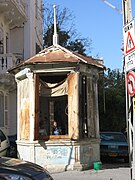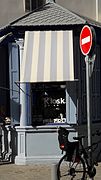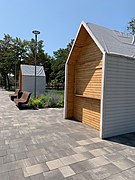Kiosk
This article needs additional citations for verification. (August 2019) |



Historically, a kiosk (from
The word is used in English-speaking countries for small booths offering goods and services. In Australia they usually offer food service. Freestanding computer terminals dispensing information are called interactive kiosks.
Etymology
Etymological data points to the Middle Persian word kōšk 'palace, portico' as the origin, via Turkish köşk 'pavilion' and French kiosque or Italian chiosco.[1][2]
History and origins
A kiosk is an open summer-house or pavilion usually having its roof supported by pillars with screened or totally open walls. As a building type, it was first introduced by the
Sultan

The first English contact with Turkish Kiosk came through Lady
European monarchs adopted the building type. Stanisław Leszczyński, king of Poland and father-in-law of Louis XV, built kiosks for himself based on his memories of his captivity in Turkey. These kiosks were used as garden pavilions serving coffee and beverages but later were converted into band stands and tourist information stands decorating most European gardens, parks and high streets.
Conservatories were in the form of corridors connecting the Pavilion to the stables and consisting of a passage of flowers covered with glass and linked with orangery, a greenhouse, an aviary, a pheasantry and hothouses. The influence of Muslim and Islamo-Indian forms appears clearly in these buildings and particularly in the pheasantry where its higher part is an adaptation of the kiosks found on the roof of
Small shops and cafés


In the
In Australia, the word is commonly used for small buildings that are used to dispense mainly
An information kiosk (or information booth) dispenses free information in the form of maps, pamphlets, and other literature, and/or advice offered by an attendant.
Interactive kiosks
An electronic kiosk (or computer kiosk or interactive kiosk) houses a computer terminal that often employs custom kiosk software designed to function while preventing users from accessing system functions. Indeed, kiosk mode describes such a mode of software operation. Computerized kiosks may store data locally, or retrieve it from a computer network. Some computer kiosks provide a free, informational public service, while others serve a commercial purpose (see mall kiosk). Touchscreens, trackballs, computer keyboards, and pushbuttons are all typical input devices for interactive computer kiosk. Touchscreen kiosks are commercially used as industrial appliances, reducing lines, eliminating paper, improving efficiency and service. Their uses are unlimited from refrigerators to airports, health clubs, movie theaters and libraries.
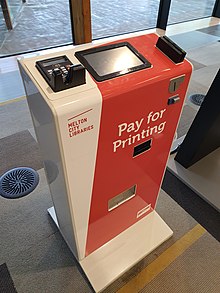
Gallery
-
Prefabricated kiosks set for different uses on the beaches of Barcelona, Spain
-
A kiosk with terrace in a park in Barcelona, Spain
-
Royal Military College of Canada information kiosk
-
Newsstand in Hong Kong
-
Newsstand in New York City, 2007
-
Ti bòlèt in Haiti
See also
- Automated retail
- Automated teller machine
- Bandstand
- Belvedere (structure)
- Dubai Smart Police Stations
- Fotomat
- Gazebo
- Pavilions
- Chahartaq (architecture)
- Self-service kiosk
- Telephone booth
- Vending machine
References
- ^ Oxford English Dictionary, 1901, s.v.
- ISBN 0-19-713559-5.
- ^ R. Halsband, The complete letters of Lady Mary Wortley Montagu, Clarendon Press, Oxford, 1965
- ^ "Town Beach Marine Rescue and Kiosk". Port Macquarie-Hastings Council. 9 July 2019. Archived from the original on 15 August 2019. Retrieved 15 August 2019.
- ^ "kiosk/cafe & bar/event space". Beach house. Retrieved 15 August 2019.
- ^ Fanning, Josh (6 December 2018). "A new take on Adelaide's old kiosk-by-the-lake: Loch & Quay is open for summer". Photos: Andrè Castellucci. InDaily. Retrieved 15 August 2019.




